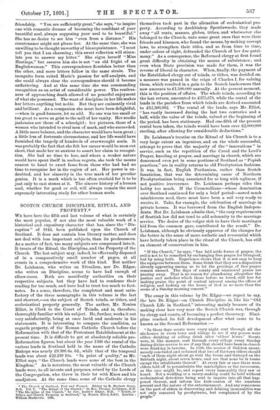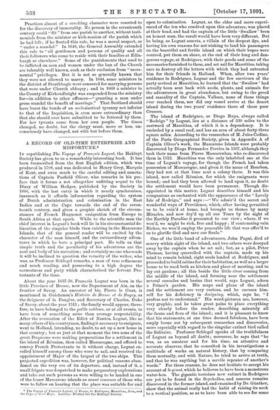SCOTCH CHURCH DISCIPLINE, RITUAL, AND PROPE RTY.* WE have here
the fifth and last volume of what is certainly the most popular, if not also the most valuable work of a historical and expository character that has, since the " Dis- ruption " of 1843, been published upon the Church of Scotland. It does not contain less literary matter, and does not deal with less important subjects, than its predecessors. As a matter of fact, too many subjects are compressed into it. It treats of the Ritual, the Discipline, and the Property of the Church. The last subject may, indeed, be effectually disposed of in a comparatively small number of pages, at all events in a comprehensive work of this kind. But neither Dr. Leishman, who writes on Bitualism, nor Dr. Edgar, who writes on Discipline, seems to have had enough of elbow-room. Both are manifestly authorities on their respective subjects, but they have had to condense their reading far too much, and have had to trust too much to foot- notes. In a sense, therefore, the completest and most satis- factory of the three monographs in this volume is the last and shortest,—on the subject of Scotch teinds, or tithes, and ecclesiastical property generally. The author, Mr. Nenion Elliot, is Clerk to the Court of Teinds, and is, therefore. thoroughly familiar with his subject. He, further, works it out very satisfactorily, being at once lucid and moderate in his statements. It is interesting to compare the condition, as regards property, of the Roman Catholic Church before the Reformation with that of the Protestant Establishment at the present time. It is difficult to get at absolutely reliable pre- Reformation figures, but about the year 1366 the rental of the various lands in Scotland held in the name of the Catholic Bishops was nearly £9,396 6s. 6d., while that of the temporal lands was about £22,239 10s. "In point of quality," as Mr. Elliot says, "the. Church lands were some of the best in the Kingdom." As is notorious, the most valuable of the Church lands were, to all intents and purposes, seized by the Lords of the Congregation, who threw in their lot with Knox and big coadjutors. At the same time, some of the Catholic clergy
• The Church of Scotland, Past and Present. Edited by B. Herbert Story, D.D. Vol. V. "The Ritual of the Church," by Rev. Thomas Leishman, DJ/ "The Discipline of the Church," by Bev. Andrew Edgar. D.D. " Teinds, or Tithes, and Church Property in Scotland," by Nenion Elliot, B.B.C. London : William Mackenzie. 1S91.
themselves took part in the alienation of ecclesiastical pro- perty. According to Archbishop Spottiswoode, they made away " all rents, manses, glebes, tithes, and whatsoever else belonged to the Church, unto some great ones that were their friends and kinsmen, who found the means, by making corrupt laws, to strengthen their titles, and so from time to time, under colour of right, defrauded the Church of her due patri- mony." As a consequence, the Reformed clergy at first found great difficulty in obtaining the means of subsistence; and even when State provision was made for them, it was the reverse of liberal in character. When, finally, the payment of the Established clergy out of teinds, or tithes, was decided on, a measure was passed in the reign of Charles I. for valuing them, which resulted in a gain to the Scotch landowners that now amounts to £1,500,000 annually. At the present moment, this is the position of affairs. The whole teinds, according to the last return, amounted to £375,678, while the rental of the lands in the parishes from which teinds are derived amounted to £12,390,992. " The rental of the lands, says Mr. Elliot, "has vastly increased during the last two centuries and a half, while the value of the teinds, valued at the beginning of the period, has been stationary. Had one•fifth of the present rental been taken, the teinds would have been over £2,000,000 sterling, after allowing for considerable deductions."
Dr. Leishman's treatise on the Ritual of his Church is to a very large extent an ingenious, and on the whole successful,
attempt to prove that the majority of the " innovations " in service, such as the repetition of the Creed and the Lord's Prayer, kneeling at prayer, and marriage in church, which are denounced even yet in some portions of Scotland as " Popish practices," are in reality returns to old Presbyterian fashions.
It was, in fact, English Puritanism, rather than Scotch fanaticism, that was the determining cause of Northern Presbyterianism being associated for so long with ugliness, if not positive irreverence. Dr. Leishman perhaps rides this hobby too much. If the Cromwellians—whose domination over Scotland continued for only a brief period—sowed much mischievous seed, there must have been a soil very ready to receive it. Take, for example, the celebration of marriage in private houses. It was borrowed from the English Indepen- dents. But Dr. Leishman admits that, " the easy requirements of Scottish law did not tend to add solemnity to the marriage service. The desire of the vulgar rich to have their marriages hid from the common gaze, contributed to the result." Dr.
Leishman, although he obviously approves of the changes for the better in the sense of more msthetic and reverential which have latterly taken place in the ritual of the Church, has still an element of conservatism in him.
"If the Church," he says, " has laid aside forms of prayer, the evil is not to be remedied by exchanging free prayer for liturgical, but by using both. Experience shows that it is not easy to keep the equipoise between them. Some think that they see a disposition already appearing among us to let the privilege of free prayer remain unused. The days of scanty and unmusical praise are passing away. That is no reason for abandoning altogether the psalms and melodies which those before us loved, still leas for making praise the point of central interest among the offices of religion, and looking on the house of God as no more than the scene of a Sunday morning concert."
The essay in this volume by Dr. Edgar—we regret to say, the late Dr. Edgar—on Church Discipline is, like his " Old
Church Life in Scotland," interesting mainly because of its making clear bow very near the Scotch Church was, through its clergy and courts, of becoming a perfect theocracy. Disci- pline reached its full development after what came to be known as the Second Reformation :-
" In those days scouts were every night sent through all the ale-houses in every town and village to see if any person were either drinking or selling drink after `elders' hours.' Scouts were, in like manner, sent through every village every Sunday during divine service to see if any that should have been in church were drinking in taverns. In 1648, the session of Galston unani- mously concluded and ordained that two of the town elders should ' each of them night about go visit the tonne and Gatesyd on the Sabbath night, about seven hours, and see that none be in tonne except the inhabitants thereof.' At every fair or race there were elders told off to perambulate the marketplace or the racecourse, as the case might be, and report every immorality they saw or heard. Not a wedding or a merry-making could be held without ecclesiastical detectives being sent to inquire into all that hap- pened thereat, and inform the kirk-session of the numbers present and the nature of the entertainment. And any remissness on the part of elders in discovering and delating immoralities was not only censured by presbyteries, but complained of by the people."
Practices almost of a revolting character were resorted to for the discovery of immorality. No person in the seventeenth century could " flit " from one parish to another, without testi- monials from the minister or kirk-session of the parish which he had left ; if he flouted this rule, he was a moral suspect, or " under a scandal." In 1648, the General Assembly extended this rule to " all gentlemen and persons of quality and all their followers who come to reside with their families at Edin- burgh or elsewhere." Some of the punishments that used to be inflicted on men and women under the ban of the Church are tolerably well known, such as their exclusion from " sacra- mental" privileges. But it is not so generally known that they were not allowed to marry. In 1644, some ministers in the district of Strathbogie were censured for marrying persons that were under Church obloquy ; and in 1668 a minister in the County of Kirkcudbright was suspended from the ministry for—in addition to other offences—" granting a man under gross scandal the benefit of marriage." That Scotland should have burst the bonds of an ecclesiastical tyranny not inferior to that of the Inquisition, is even more extraordinary than that she should ever have submitted to be fettered by them. For her tyrants came from her own people. The times changed, no doubt, but the clergy must, more or less, un- consciously have changed, not with but before them.



































 Previous page
Previous page